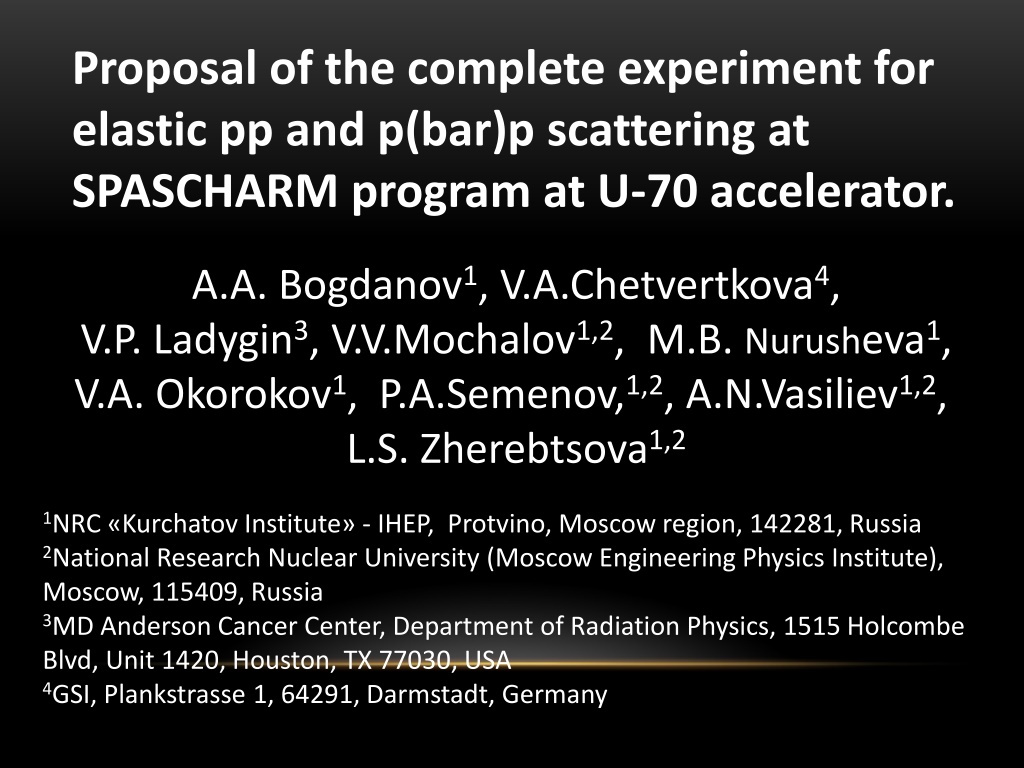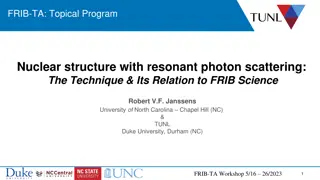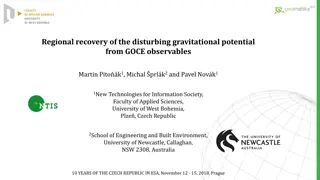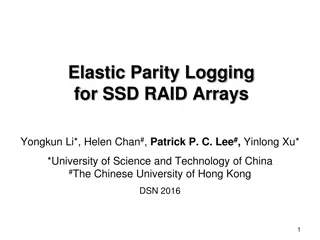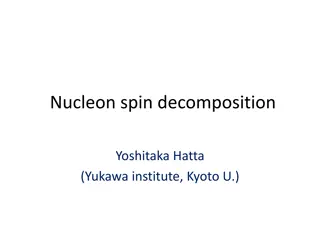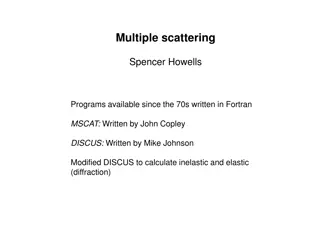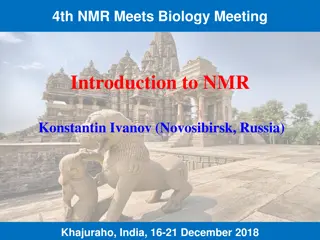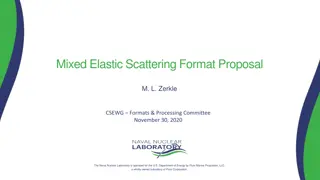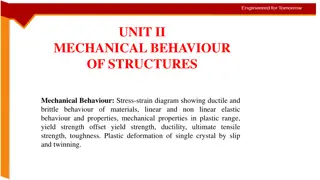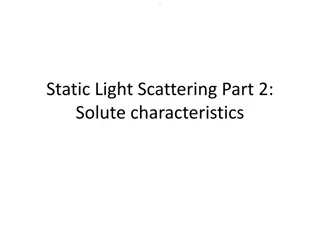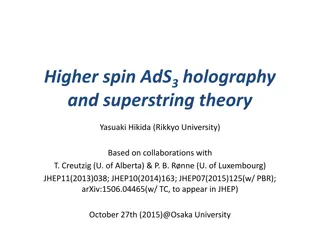Investigation of Spin Observables in Elastic pp and p(bar)p Scattering at SPASCHARM Program
Measurements of spin observables in elastic pp and p(bar)p scattering at 16 GeV will be conducted at the SPASCHARM program using a unique setup with polarized proton and antiproton beams. The experiment aims to extend the energy range for spin studies and compare elastic scattering in pp and p(bar)p interactions.
Download Presentation

Please find below an Image/Link to download the presentation.
The content on the website is provided AS IS for your information and personal use only. It may not be sold, licensed, or shared on other websites without obtaining consent from the author. Download presentation by click this link. If you encounter any issues during the download, it is possible that the publisher has removed the file from their server.
E N D
Presentation Transcript
Proposal of the complete experiment for elastic pp and p(bar)p scattering at SPASCHARM program at U-70 accelerator. A.A. Bogdanov1, V.A.Chetvertkova4, V.P. Ladygin3, V.V.Mochalov1,2, M.B. Nurusheva1, V.A. Okorokov1, P.A.Semenov,1,2, A.N.Vasiliev1,2, L.S. Zherebtsova1,2 1NRC Kurchatov Institute - IHEP, Protvino, Moscow region, 142281, Russia 2National Research Nuclear University (Moscow Engineering Physics Institute), Moscow, 115409, Russia 3MD Anderson Cancer Center, Department of Radiation Physics, 1515 Holcombe Blvd, Unit 1420, Houston, TX 77030, USA 4GSI, Plankstrasse 1, 64291, Darmstadt, Germany
We suggest to carry out the measurements of the pp and p(bar)p elastic scattering spin observables at 16 GeV/ (direct reconstruction of elastic pp and p(bar)p scattering amplitudes at SPASCHARM experiment). To date the direct reconstruction of amplitudes for pp elastic scattering has performed up to 6 GeV/c [1,2] We suggest to carry out the measurements of the pp and p(bar)p elastic scattering spin observables at 16 GeV/ (direct reconstruction of elastic pp and p(bar)p elastic scattering amplitudes at SPASCHARM experiment). To date the direct reconstruction of amplitudes for pp elastic scattering has performed up to 6 GeV/c [1,2] only, while there is no available data for p(bar)p elastics scattering. New measurements at SPASCHARM will significantly extend the energy range of the spin studies and will give unique possibility to compare elastic pp and p(bar)p scattering. To date the direct reconstruction of amplitudes for pp elastic scattering has performed up to 6 GeV/c [1,2] only, while there is no available data for p(bar)p elastics scattering. only, while there is no available data for p(bar)p elastics scattering [1] J.Bystritcky, C.Lechanoine-Leluc, F.Lehar, Eur.Phys.J C4 (1998) 607. [2] I.P.Auer et al., Phys.Rev. D32 (1990) 2689
Newly developing SPASCHARM (SPin Asymmetry in CHARMonia) experiment at U-70 accelerator will give the unique possibility to measure spin effects with the use of polarized proton and antiproton beams and polarized target.
In order to measure all possible spin observables one needs a polarized proton target, a polarized proton (or antiproton) beam, and analyzers of the polarization of the recoil proton and the scattered proton (or antiproton). While there are standard techniques to polarize a proton target, a high-intensity polarized antiproton beam does not exist yet. In our experiment the beam will be polarized along three directions, while the targets will be polarized at one direction.
The SPASCHARM setup possibilities The main beam will be delivered to external target (up to 2 1013p/cyc.) to create secondary polarized proton and antiproton beams due to parity-violating decays of and (bar) -hyperons Main optic scheme quads, dipoles collimators, , exp targets (channel and experiment), green spin flipper (Novosibirsk - Shatunov see SPIN2012) for polarized beam from hyperon-decay. Q
After the Lorentz boost into the laboratory frame transversely polarized portions of the total beam are selected, using the particle s trajectory tagging or collimation. Tagging system allow to measure polarization of EACH particle and use most of the beam.
TAGGING SYSTEM Tagging system allows for each particle to measure position in both directions (X and Y) in intermediate focus and momentum with an accuracy better than 1% So we can select the events as elastic on the dual criteria of coplanarity and agreement to the scattering angles with kinematics . [Nurushev et. al. XV Advanced Research Workshop on High Energy Spin Physics (DSPIN-13), p. 267]
Polarized proton beam parameters at the experiment target. Due to much lower yield of (bar)-hyperons compared to , an intensity of a 15-16 GeV/c polarized antiproton beam is by a factor of 20-30 as low as of a proton beam. So an intensity of 16 GeV/c polarized antiproton beam with a wide momentum spread is estimated to be 4 105per 1013of primary protons. DECAY TURTLE Simulations
The intensity of polarized proton (left frame) and antiproton (right frame) beams with the maximum p/p per 1013of 60 GeV primary protons Azhgirey et al 2017 J. Phys.: Conf. Ser. 798 012177
The high pion background to antiprotons from p- decays might make it not feasible operating antiproton beam at momenta below 16 GeV/c. This fact motivated us to choose the following kinematic region : beam momentum pb=16 Gev/c and t = 0.3 (GeV/c)2 ? The background to antiprotons from K Ks0 + -decays is expected to be suppressed by the beam Cherenkov counters.
Notation For discussion the complete experiment we have to introduce some notation. We denote a general scattering observable by Xbtsr, where the indices denote the spin direction of the particles: b = beam, t = target s = scattered, and r = recoil, Ann Arbor Convention
The polarizations of the incident and target particles in the laboratory system are oriented along the basis unit vectors k n along the particle momentum, normal to the production plane, s = n x k No prime for initial particles The prime in superscript for scattered particles. Double primes for recoil.
The unit vectors n, s, and k for the beam and target laboratory frame, and n, s ", and k" for the recoil particle frame.
Definition of transverse-polarization and longitudinal-polarization. the proton spin direction
longitudinally polarized beam and target Akkoo Dokos Kkoos Nkkon transversally polarized beam and target Anooo = Aonoo Annoo Donon Knoon beam polarization oriented in the (n, s ) plane and the target oriented in the k direction Askoo Dokon Nskon
Complete set of observables Note that in our experiment the beam will be polarized along n, s or k while the target will be polarized along n or k and the components n and s" of the recoil particles will be analyzed. So the complete set of 11 observables is: , P, ANN, ALL, ASL, DNN,DLS, KNN, KLS, NLLN, NSLN
SPASCHARM EXPRIMENT PHYSICS Single spin asymmeties: reactions, including elastic, of the light (u, d, s quarks) hadrons in the with polarized beam or target inclusive and exclusive beam fragmentation region The hyperon and vector mesons polarization and depolarization Study dependence on kinematic values (0<xF <1, 0< pT<2.5, 12<EBeam <70 GeV), event multiplicity and atomic number with high precision due to full azimuthal coverage within the wide aperture Double-spin asymmetry ALL in charmonium production to study gluon polarization G/G(x) at large xF
The polarized target parameters Target dimensions d =20 mm, l=200mm Material of target Concentration Cr2 Maximal polarization Magnetic field Polarization building time Dynamic polarization regime C5H12O pentanol 44 g 1.5*1020sm-3 75% 2.,4 T 60 min (P = 80%) T=0.3 K, SHF power=100 mVt, f=56 GH, ns= 3*10-2 mole/s P+=1% P-=2% Polarization disintegration during 24 h, T=0.02 K at field 0,45 T
We estimate the expected accuracy of determining the beam polarization as follows. If the unknown beam polarization is denoted by PB, the analyzing power of elastic pp scattering at fixed s and t - as AN, the raw left - right asymmetry as , then we have the relation: PB= / AN. [ ( PB)/ PB]2= [ ( )/ ]2+ [ (AN)/AN]2 maximum accuracy of polarization measurements is achieved if ( )/ << (AN)/AN This condition may require a large amount of beam time, so we take ( )/ = (AN)/AN
I = 4104 ( /cycle) Time measurement estimation with antiproton beam. n=L?? ?? t / - the expected account for second , where L= I ?? ? l luminosity = 0,1 - duty cycle of a beam I = 4 105 ( ?/ cycle) - intensity A - atomic weight of a target nuclei PT = 0,12g/cm3- density of polarized target at low temperature l = 20cm - target length
To estimate the beam run time for ANN the following initial conditions were taken into account : The polarized beam parameters : Beam momentum pb=16 Gev/c Duty factor =0.1, beam pulse duration - 1 s The polarized target parameters Intensity I=4*105 Beam polarization PB=(45 3) % The beam luminosity L=1028 m-2s-1 The polarized target parameters: Target dimensions d =30 mm, l=200mm The target material C5H12O pentanol The polarized proton density =0.12 g/ m3 Magnetic filed at the dynamic polarization B=2.5 T Target polarization PT=(75 3) %
Numerical calculation the number of elastic scattering events were done at the maximum value of t = 0.3 (GeV/c)2 and t= 0.1(GeV/c)2. From relation n=L t d /dt / , where d /dt =8 mb/(GeV/c)2 and / =0,1 Finally the counting rate n=0,1047 s-1. Therefor the expected value of ANN=5,25 % . In order to measure this parameter with precision ANN/ANN= 0,15 one needs the - 16 days The parameters AN and P will be measured with precision 10% at the same t = 0.3 (GeV/c)2, and the beam running time will be 13 days. So the total time - 29 days. Mach better precisions for this observables are expected at the smaller t values. [Antipov A et al 1976 Elastic scattering of , K mesons and protons on protons at momenta 29-65 GeV/c Preprint IHEP 76-95]
Conclusion We present the complete set of 11 observables : , P, ANN, ALL, ASL, DNN, DLS, KNN, KLS, NLLN, NSLN for direct reconstruction of elastic pp and p(bar)p scattering amplitudes at SPASCHARM experiment For the first stage of SPASCHARM program , when the transversally polarized beam and target will be used, we estimated run time for measurement of spin correlation parameter ANN , analyzing power AN and polarization P for antiproton beam. The total time is 29 days The polarized proton beam intensity is by a factor of 25 as higher as of a antiproton beam. So the run time for proton beam will be at term 5 less , and equaled 6 days.
